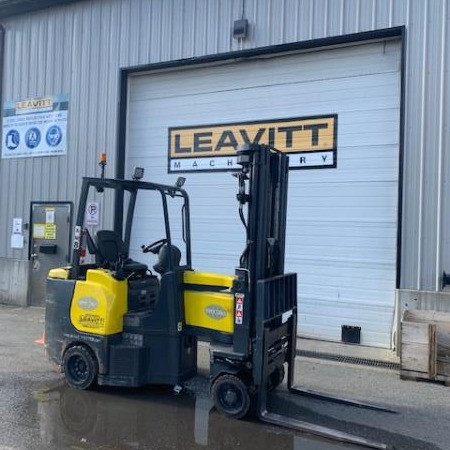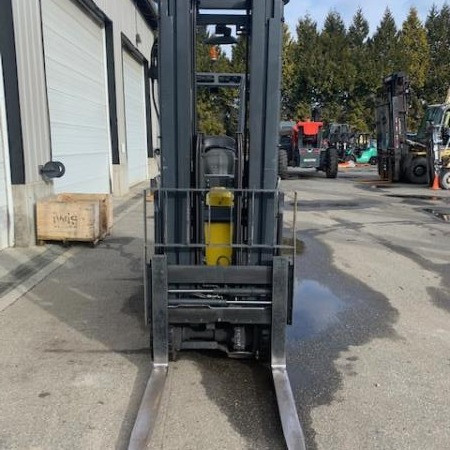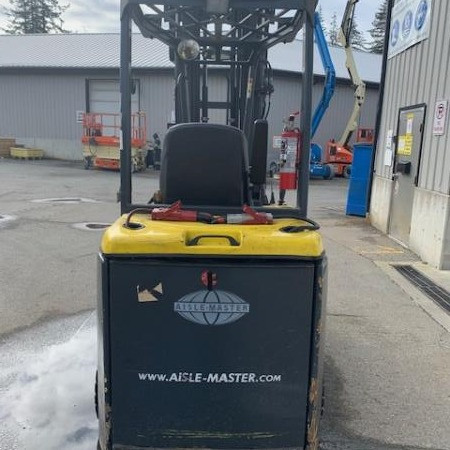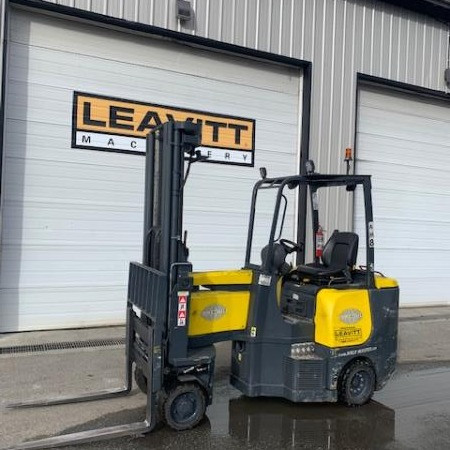Very Narrow Aisle Forklift Missouri
Used Very Narrow Aisle Forklift Missouri - Warehousing needs greatly focus on space-saving techniques and layout to maximize expensive square footage and decrease travel time needed to get goods from the loading docks and from point A to point B. Narrow aisles need specific solutions to allow goods to be accessed and stored properly. More space can be given to storage as less space is needed for accessing the aisle. These warehouse configurations are often referred to as warehouse optimization.
Warehouse Optimization
Several benefits can be enjoyed for adding very narrow aisle warehouse optimization such as more storage space for the facility.
Because very narrow forklift trucks were developed to take up less space in maneuvering, it is now possible to decrease warehouse aisle width to less than half the width required by standard forklifts. Many very narrow aisle forklifts offer greater stack height capability which further increases the storage capacity per square foot. This means that costs are decreased because less warehouse space is necessary for the same amount of stock than if a standard aisle configuration were used. In most urban areas where square footage is very costly, this is a huge benefit to warehouse operations. When planned carefully and properly, it is possible to increase warehouse storage area by up to 80 percent by implementing a very narrow aisle width configuration. Very narrow aisle design facilitates greater product access and more rack faces. This usually equates to less travel time gathering and storing product as more product is located within a smaller, more accessible area.
Very narrow aisle layouts and narrow aisle layouts are popular for warehouses. Narrow aisles are measured as those that use fewer than eleven feet of aisle width. These widths reduce even further to roughly 6.5 feet for very narrow aisles. Both of these aisle widths provide significantly increased storage opportunities. Using a forklift for order picking and stocking can be difficult in these aisle widths, especially when turning. These challenges are met by using very narrow forklifts to gain access and complete tasks.
Before choosing a forklift for a particular job, it is vital to know the dimensions of the aisle. Taking note of the proper dimensions will save valuable time and money by avoiding the mistake of acquiring a forklift that will not work in the intended application. It is essential to take any columns, posts or utilities into account before deciding a type of narrow aisle forklift design as these can block access.
Very Narrow Aisle Forklift Trucks
Rechargeable batteries are typical for powering very narrow aisle forklift trucks and most models are electric. Very narrow aisle forklift trucks are popular as stand-up riders to help increase operator comfort and productivity. There are different very narrow aisle forklift designs such as order pickers, reach trucks, wing-mast or turret and end-control riders.
Reach Forklift Trucks
Developed as a kind of rider stacker forklift, the reach forklift trucks can be configured for narrow aisle locations. The reach trucks developed their name from their forward-reaching actions to get a load. There are two types of reach trucks: the moving mast and the moving carriage. The moving carriage works by raising and lowering the carriage, along with the operator. The moving mast raises and lowers the forks as the operator remains at ground level. The moving mast reach truck is generally considered the safer of the two types of reach trucks. Reach trucks use a pantograph system, a type of jointed framework, which allows the operator to reach for or place a load without the need to move the forklift itself.
Order Pickers
Order pickers were created to specifically pick orders from difficult-to-access racks. Order pickers are specific for lighter stock items that can be lifted by hand. These order pickers work by lifting the operator up to the level of goods in order to identify and pick the specific item or items necessary to fill an order.
End-Control Riders
End-control riders are used to pick loads located at floor level and transport the load horizontally, rather than lift or lower loads from various heights.
Turret or Swing-Mast Forklift
Swing-mast or turret very narrow aisle forklifts feature an articulating swivel mast that pivots. The mast swivels to enable pallets to be positioned on the right or left side of the forklift.
Guided Very Narrow Aisle Trucks
Very narrow aisle forklift trucks can be guided by rail or wire down the aisles.
Since the forklift truck is guided, the chance of colliding with racks while traversing down the aisles is very low. For rail-guided systems, a series of rails are installed into the floor, on both sides of the aisle, and run along the floor for the length of the aisle, curving around the end of the aisle. Specific wheel guides are on the forklift. These slide into the rails to stop the forklift from moving out of the rail guards.
Running down the center of the aisle, wire-guidance forklifts rely on floor wires instead of rails. Narrow aisle forklifts rely on a wire-guide system to help it communicate with the floor wires. This allows the machine to be steered by the wires, stopping it from traveling outside of the specific location.
Work Site Considerations
Certain essential considerations need to be dealt with before using a narrow aisle configuration. The narrow aisle units feature tall racking systems. The floor construction and the racks need to be carefully taken into account for everyone’s safety. There are four areas which must be meticulously prepared before setting up a racking system and must be continuously monitored and maintained throughout the operation of the warehousing system:
1. The floor must be level;
2. Cracks must be repaired;
3. Load capacity of floor must be appropriate; and
4. The racks must be plumb.
Level Floor
Due to the racking system height, any minor floor slope can gravely impact how plumb the racks are, particularly over time if loads are placed and removed repeatedly on the racks. The height of the racking system means that any minute floor slope can have a negative impact on how straight the racks are, especially over time when loads are continually removed and placed on the racks. Without a level floor foundation, the rack stability could be compromised.
Crack Repair
Cracks in the floor ideally should be fixed once they are noticed to ensure everyone’s safety. The level of the floor can become unstable with cracks when they are only 3/8 inches wide. They will need to be filled properly with material as hard as the rest of the floor.
Floor Load Capacity
The floor should meet certain minimum requirements before considering a narrow aisle configuration. At a minimum, the floor should consist of 3,000 psi concrete as well as contain evenly distributed rebar approximately 3 to 4 inches below the surface. Depending on the configuration and load requirements, extra reinforcements may be necessary.
Plumb Racks
Of great importance is the proper installation of the racking system. If installed improperly, there is a great chance of rack failure. Every rack needs to be plumb to ensure a safe system and work environment. Rack shims can help the rack stay plumb to one inch at the height of thirty feet.
If the above measures are not taken or are improperly implemented, it is likely to cause a racking failure. Employees can become hurt or killed in the event that racking failure occurs. Goods can be damaged along with forklifts and other equipment. Because of these reason, these measures are the most important part of implementing a narrow aisle configuration for warehousing optimization.
Very Narrow Aisle Forklift PDF
Stock Number: 209213 GL
Make: AISLEMASTER
Model: 44SE
Year: 2015
| Stock Number |
209213 GL |
| Make |
AISLEMASTER |
| Model |
44SE |
| Year |
2015 |
| Category |
Very Narrow Aisle Forklift |
Stock Number: 208758 GL
Make: AISLEMASTER
Model: 44SE
Year: 2015
| Stock Number |
208758 GL |
| Make |
AISLEMASTER |
| Model |
44SE |
| Year |
2015 |
| Category |
Very Narrow Aisle Forklift |
Stock Number: 207213 GL
Make: AISLEMASTER
Model: 44E
Year: 2013
| Stock Number |
207213 GL |
| Make |
AISLEMASTER |
| Model |
44E |
| Year |
2013 |
| Category |
Very Narrow Aisle Forklift |













